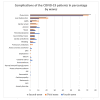Clinical Profile of COVID-19 Patients Admitted at a Private Hospital During Three Surges in Mandalay, Myanmar
- PMID: 36960252
- PMCID: PMC10030156
- DOI: 10.7759/cureus.35167
Clinical Profile of COVID-19 Patients Admitted at a Private Hospital During Three Surges in Mandalay, Myanmar
Abstract
Introduction During the coronavirus disease 2019 (COVID-19) pandemic, private hospitals in Mandalay started to manage COVID-19 infections according to national treatment guidelines since February 2021. Variations of clinical characteristics and their outcomes in different surges could be evaluated in the private hospital. This study aimed to assess the clinical profile and outcomes of COVID-19 patients admitted at a private hospital during three surges in Mandalay. Methods This study is a retrospective record review of the case series of COVID-19 patients admitted at City Hospital, Mandalay. The study was conducted from January to December 2022. All of the hospital records of COVID-19 patients admitted during the second wave from February 2020 to 26 May 2021, the third wave from 27 May 2021 to 27 January 2022, and the fourth wave from 28 January to April 2022 were included in the study. Results A total of 1606 admitted cases were included in the study. The mean with standard deviation (SD) of age was 55.7±18.5, and males were 778 (48.4%). The mean duration of hospital stay in days was 10.8±5.94, 10.6±6.11, and 7.3±2.88 in second, third, and fourth waves, respectively. The mean duration of hospital stay was shortened in the fourth wave. Comorbid conditions with hypertension and/or diabetes diseases were mostly observed in three waves of COVID-19 infection. Fever was the most presented symptom in three waves. Cough, sore throat, and rhinorrhea were observed more in the fourth wave compared with previous waves. Complication with pneumonia (71.3%), liver dysfunction (21.0%), acute respiratory distress syndrome (10.0%), thrombocytopenia (6.2%), acute kidney injury (5.5%), bleeding (3.9%), and pulmonary embolism (2.9%) were investigated. Antiviral treatment such as remdesivir or molnupiravir was used more in the patients of third and fourth waves than those of the second wave. Oxygen therapy (59.9%), prone position (35.5%), non-invasive ventilation (9.5%), invasive ventilation (0.5%), inotropes (4.6%), and renal replacement therapy (1.1%) were recorded in serious cases. Only 7.9% and 9.4% died in the hospital in second and third waves. No mortality was observed in the fourth wave. Conclusions The study recommended that COVID-19 patients with comorbid conditions of hypertension or diabetes and ages 65 and older should be taken with intensive care support at the hospital. This study also concluded that a private hospital in Mandalay could tackle with COVID-19 severe cases in line with national treatment guidelines since the second wave and could provide better management in the fourth wave. Antiviral treatment should be used in severe COVID-19 cases for further emergency management. In conclusion, private hospital involvement in the COVID-19 pandemic is supportive of the healthcare provision in Myanmar in an emergency situation.
Keywords: clinical profile; covid-19; myanmar; private hospital; waves.
Copyright © 2023, Kyu et al.
Conflict of interest statement
The authors have declared that no competing interests exist.
Figures


References
-
- World Health Organization: the WHO global clinical platform for COVID-19. 2020. https://www.who.int/teams/health-care-readiness/covid-19/data-platform https://www.who.int/teams/health-care-readiness/covid-19/data-platform
-
- World Health Organization (WHO). (2020. World Health Organization: antigen-detection in the diagnosis of SARS-CoV-2 infection. 2020. https://www.who.int/publications/i/item/antigen-detection-in-the-diagnos... https://www.who.int/publications/i/item/antigen-detection-in-the-diagnos...
-
- World Health Organization: therapeutics and COVID-19: living guideline. 2021. https://www.who.int/publications/i/item/WHO-2019-nCoV-therapeutics-2022.4 https://www.who.int/publications/i/item/WHO-2019-nCoV-therapeutics-2022.4 - PubMed
-
- Surviving sepsis campaign: international guidelines for management of sepsis and septic shock: 2016. Rhodes A, Evans LE, Alhazzani W, et al. Intensive Care Med. 2017;43:304–377. - PubMed
LinkOut - more resources
Full Text Sources
Miscellaneous
